There’s More to the Story
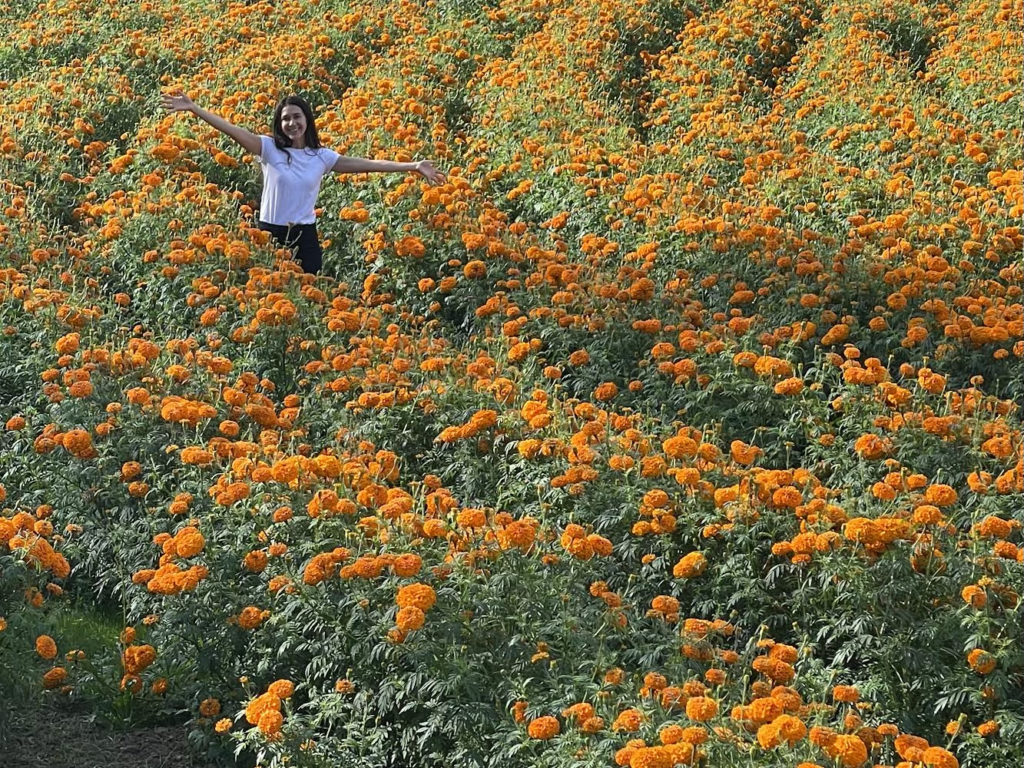
“Every picture tells a story” they’ll tell you. And it’s probably “a thousand words” long, too, if the clichés are to be believed. But I wonder if maybe it isn’t the frame that’s the most important part of any picture? How you choose to frame an image both limits and focuses any intended expression. Another person, finding themselves in the same circumstances with the same camera as you, might react with a snapshot that tells an almost entirely different tale simply by framing the moment from a different perspective. One of my favorite pictures that I took this year was of Kelly waving up at me from inside the marigold patch. The image captured a moment of joy and color for me, and it confirmed all the choices I’d made about what kind of marigolds to plant and when to plant them. We were inspired to plant a marigold crop to coincide with Diwali and Dia de los Muertos festivities and, with some friendly mentoring from our friends at Arnosky Family Farm in Wimberly, Texas, we got the right seed, planted it at the right time, and totally nailed the moment. The flowers were fun to grow, beautiful, aromatic, and catalytic too, because they prompted us to meet some new people and engage with new communities.
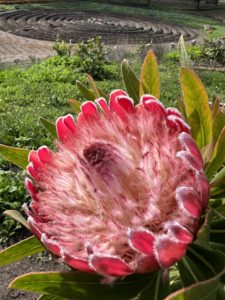
A different perspective of the labyrinth.
A different photographer visiting the farm might have focused on an entirely different scenario. If you choose to employ a wide angle setting, you can paint an entirely different picture than that of a young woman smiling in a field of gold. A wider perspective can take in the labyrinthine pattern of garden bends dug into the field just beyond the marigolds and planted out in lavender. From above, looking down on the field from a bird’s eye view it might look for a moment that there was a crop circle carved into the land. But there’s nothing alien about this labyrinth; Starr and I created it ourselves as our homegrown Covid project to broadcast some positive energy back at the world around us. Labyrinths are mysterious. We chose to model our homegrown labyrinth on the eleven circuit labyrinthine mosaic that was set into the floor of the Chartres Cathedral in France back in the Middle Ages. We bordered our labyrinth’s path in lavender because lavender is a very hardy, drought tolerant, healing herb. This earth-art project has been a couple of years in development and execution and it felt good to get it finished this year. One of the fun things about the labyrinth is that our cats often come down to join us when we’re working on it. Here’s a picture of Samson, our apricot-blond dreamboat of a cat, watching us weed the lavender beds on a mild, fall afternoon. We look forward to inviting you down in the spring to walk the labyrinth when it’s grown out more fully and in full bloom.
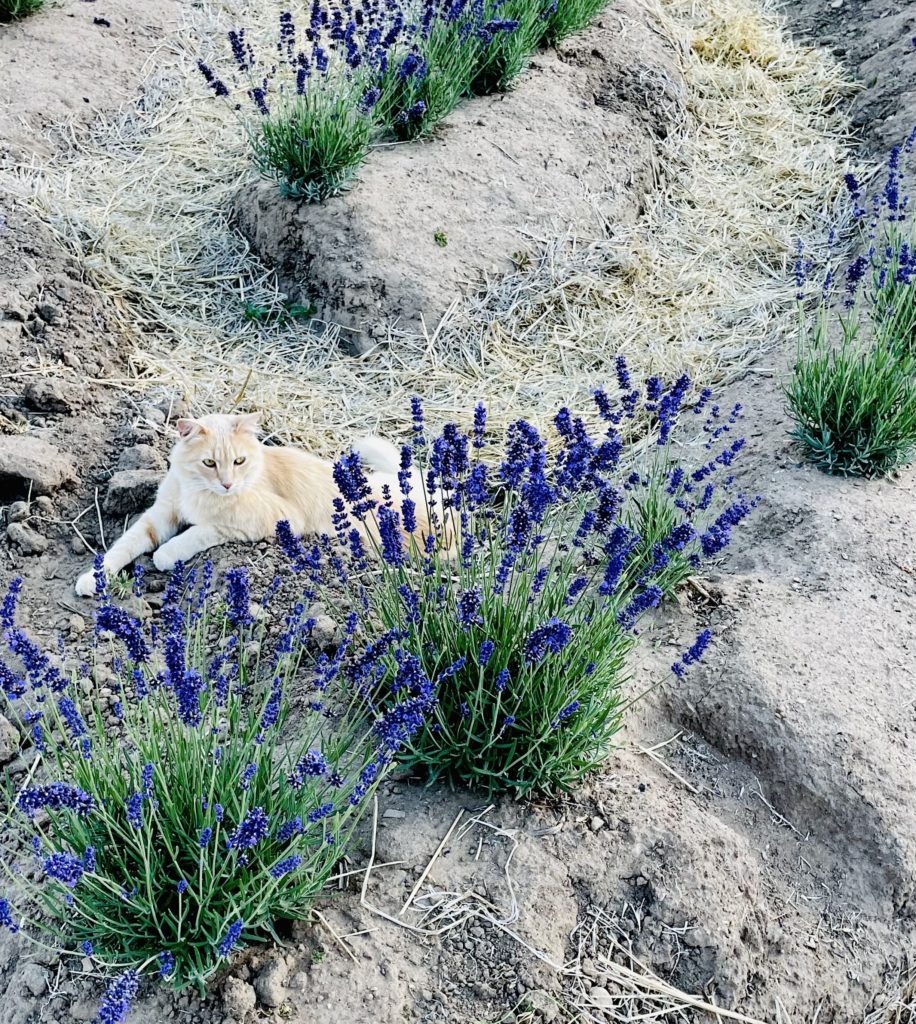
Samson in the Lavender beds.
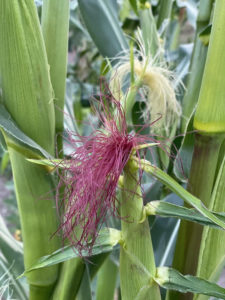
Corn silk in the milpa.
Sometimes I’ll go on Google Earth to get a satellite’s super-wide view down on the farm. The last time I checked NASA had not yet swept overhead to record the milpa that we planted to embrace our labyrinth garden. A milpa is a classic indigenous Mexican planting scheme where the “holy trinity” of corn, squashes, and beans that are planted out together. In the dream world of a perfect milpa, the squash spread out across the earth, with their broad leaves choking out any malignant weeds. The corn stalks poke up through the canopy of squash foliage and the beans twine up the corn stalks. Corn, squash, and beans make a well-rounded diet for the human body and the plants are complementary in the field too. In a perfect milpa the weeds are succulent purslanes, glaucous quantities, and purple, wild tomatillos, each a nutritious complement to field and body, and weedy only in the sense that these plants defy any attempt to discipline them. The milpa worked out well this year and I have plans for next year’s milpa already. We will switch out the marigolds and plant them where the milpa was this year, and vice versa. Marigolds make an excellent rotation crop for food crops as they tend to suppress soil pathogens. We will put the corn, squash, and beans where the marigolds grew this year. We’re putting a nitrogen fixing cover crop on this ground next week, before the next rain hits. For a fun twist on the classic Mesoamerican milpa logic we will use an Italian heirloom polenta corn called “Otto File” for the corn part of the equation, and an heirloom Italian hard squash, the Rugosa butternut, to stand in for the squash component, and Japanese runner beans to be the legumes that will complete the trinity. Think of next year’s milpa as a fantasy garden planted somewhere along the Oaxacan/Italian/Japanese frontier. We had a fun farm tour this year when we participated in the Open Farm tour, and we plan to repeat and improve upon that experience.
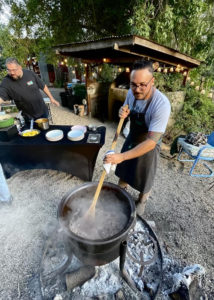
Greg and Gus from the Dream Inn.
In 2023 we are focusing on welcoming visitors to the farm for events and workshops. Opportunities for small groups of 60 or less people can rent the gardens for staff parties and meetings, workshops, weddings, divorce parties and much more. Starr and I were happy to host The Dream Inn, from Santa Cruz, early this fall when the kitchen put on a special meal for their partners and associates in the media. It was fun to break out my heirloom cauldron that my Grandma used to cook beans in, back when she was a ranch cook in the 1930s and 40s. Keep an eye on our newsletter for updates about upcoming events and workshops that we will host in the spring and summer. The rose gardens are a sight to see and we hope to showcase them in April and May. In the short term, after we return from a brief Thanksgiving break, we plan to have a few popups in December before the winter holidays.
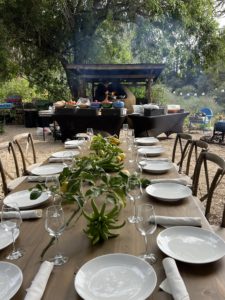
The table is set!
Wishing you all a full table of bounty!
Andy, Starr and the Crew at Mariquita Farm
© 2022 Essay by Andy Griffin
Photos by Andy Griffin and Starling Linden


